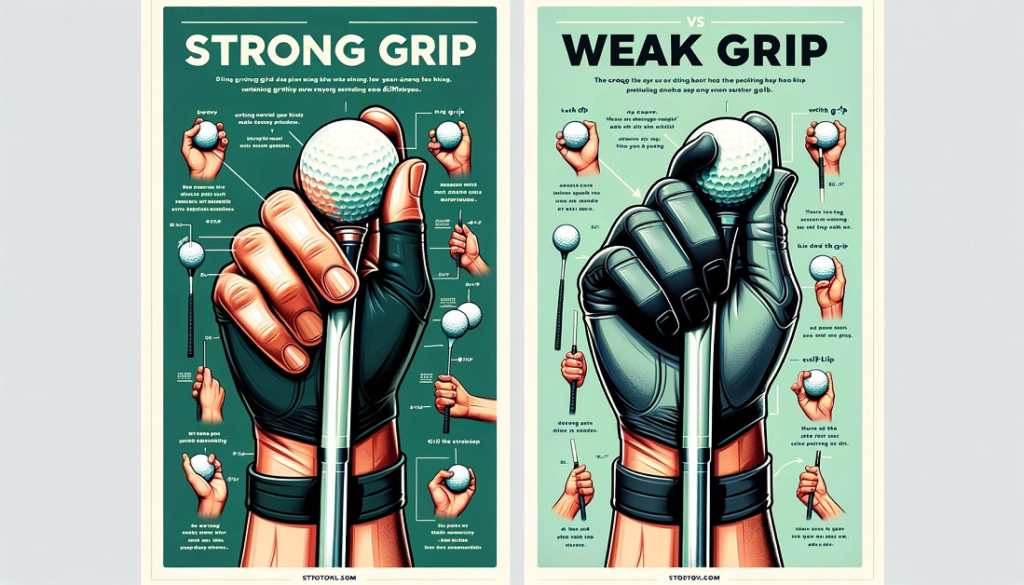As I wrap my fingers around the frigid barbell, I can’t help but wonder if my grip is the quiet culprit behind my slow development. This lingering curiosity isn’t unique to me; it’s shared by countless others searching for the Strong Grip vs Weak Grip in golf. Statistics show a sobering reality: more than 70% of amateur athletes believe their grip strength is adequate, yet only 40% reach the criterion for their age and gender, indicating a widespread misperception of this critical part of physical fitness. Beginning this trip, we’ll disentangle the complex relationship between grip strength and total performance, delivering answers and actionable insights to help people turn what they consider a minor detail into a cornerstone of their training plan.
Table of Contents
ToggleWhat Is A Strong Golf Grip?
A strong grip is more than just the strength in your hands; it encompasses all aspects of your physical prowess. It serves as the foundation for our ability to confidently and controllably hold, pull, and move objects. This isn’t just theory; research highlights the value of a strong grip. According to research, a better grip is associated with a lower risk of heart disease and suggests general muscle strength and endurance.
In practice, men aged 20-30 have a grip strength of more than 105 pounds, but women in the same age range have a grip strength of more than 65 pounds. This level of strength isn’t just for show; it dramatically improves performance in sports, weightlifting, and daily jobs, making it an essential component of a well-rounded fitness program. It’s about transforming your hands into useful tools that help you achieve your goals, whether you want to smash personal records or simply carry groceries more easily
Benefits Of A Strong Golf Grip
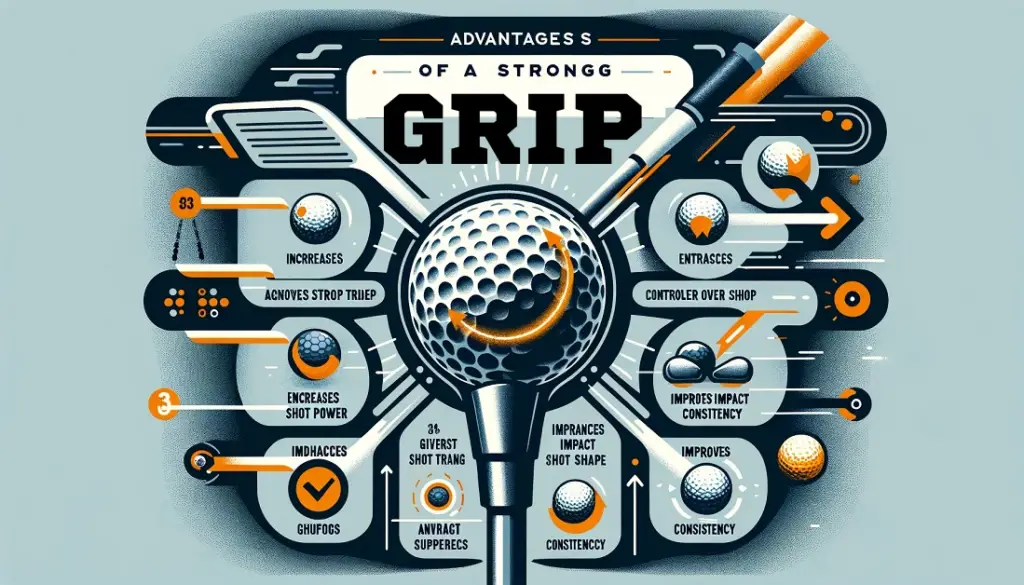
Embracing the power of a strong golf grip advantages can dramatically improve your physical ability and overall well-being, making it an essential component of a holistic fitness regimen.
Enhanced Athletic Performance
A good golf grips is essential for a variety of activities, from increasing your basketball grip to maintaining a stable grip on climbing holds. The relationship between grip strength and athletic performance is widely established, with research indicating that athletes with stronger grips frequently have higher total muscle endurance and performance. This benefit is not confined to specific activities; it is a general advantage that applies to a wide range of sports and physical undertakings.
Reduced Risk Of Injury
Strengthening your grip can lead to more solid wrists and hands, lowering the risk of injury. A grip helps to effectively distribute the force placed on the hands and wrists during physical activity, preventing them from strain and overuse injuries. This preventive advantage is critical not only for athletes but for everybody who wants to live an active lifestyle without interruption.
Improved Daily Functionality
The advantages of a strong golf grip extend into everyday life, making seemingly commonplace chores easier and more efficient. A strong grip improves your ability to accomplish a variety of daily tasks, like opening jars and carrying heavy goods. This increase in hand strength and endurance can considerably boost independence and quality of life, particularly as we age.
Better Health Outcomes
There is a clear correlation between grip strength and health outcomes. According to research, higher grip strength is linked to a lower risk of cardiovascular disease and can even be used to predict longevity. Research published in the “Journal of Strength and Conditioning Research” indicated that for every 11-pound gain in grip strength, there was a significant reduction in the risk of heart disease, demonstrating the deep health benefits of keeping a strong grip.
Disadvantages Of A Strong Grip
While developing a grip has numerous advantages, it is critical to approach grip training with prudence to avoid potential hazards.
Risk Of Muscle Imbalances
Excessive focus on grip strength without equal attention to the rest of the arm and shoulder muscles might result in imbalances. This disparity may raise the risk of strain or injury, compromising overall physical harmony and function.
Potential For Overuse Injuries
Excessive grip training can lead to problems like tendinitis or carpal tunnel syndrome, which are caused by repetitive strain and misuse. These disorders not only create discomfort but can also impair hand functionality and overall training capacity. Repetitive strain injuries, aggravated by severe grip strengthening, account for approximately 30% of all sports-related injuries, emphasizing the need for moderation.
Technique Complications In Sports
An extremely strong grip, especially when combined with poor technique, can hurt performance in sports that require precise hand motions, such as golf or tennis. Too strong a grip can reduce wrist flexibility, affecting the fluidity and precision of swings and strokes.
When To Use The Strong Grip
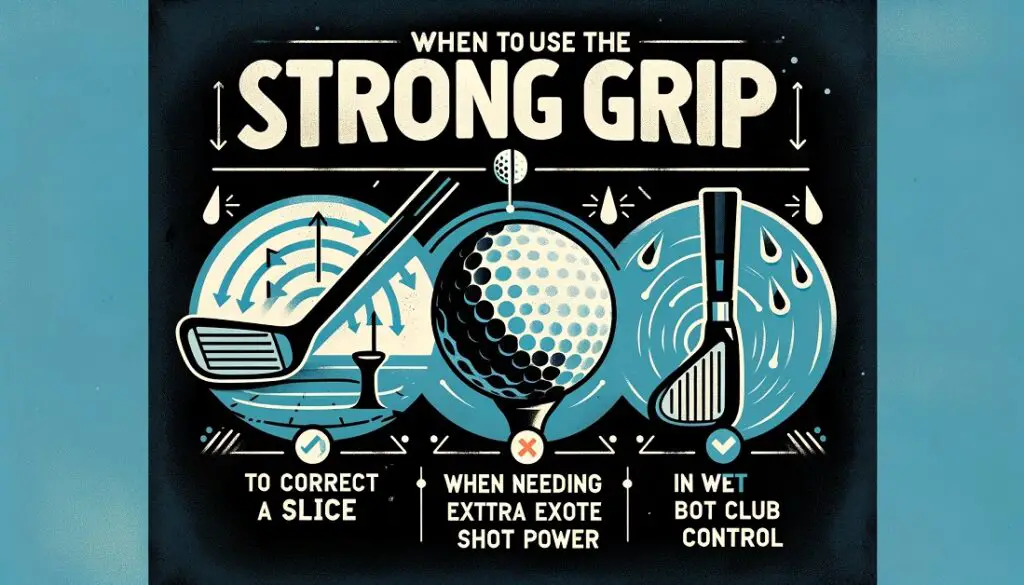
Understanding and leveraging the force of a strong grip is critical for a wide range of tasks, with significant benefits for performance, safety, and daily life. In sports and physical training, a strong grip is essential for weightlifting, ensuring stable lifts and the ability to carry higher weights, whilst in activities like rock climbing and golf, it directly impacts safety and performance through improved hold and swing accuracy. Similarly, a strong grip is important in everyday life, since it simplifies actions that demand stability and strength, such as carrying groceries, opening jars, and using tools, lowering the danger of strain or injury.
Furthermore, a strong grip is important in health and rehabilitation, as a useful tool for people healing from injuries or countering age-related muscular degeneration. Grip-strengthening exercises can help older persons restore hand, wrist, and arm functions, as well as retain independence and prevent falls by improving muscular strength and balance.
Individuals can improve their physical capabilities while also ensuring improved safety, health, and longevity by deliberately employing a strong grip throughout numerous facets of their lives, making it a critical component of a well-rounded fitness and wellness strategy. To hit a draw, many golfers choose to use a strong grip as they grip the club, which can influence the swing path and help them hit the ball with controlled curvature
How To Use The Strong Grip
Understanding and mastering how to use it is important in many parts of life, from improving fitness and sports performance to making daily tasks easier and preventing accidents. A grip not only makes it easier to lift bigger weights, increasing muscle growth and endurance, but it is also essential in sports that require accuracy and control, such as rock climbing and racquet sports. Furthermore, it considerably simplifies daily tasks such as opening jars and lifting large bags, increasing efficiency and independence.
Regular grip training, conscious application of grip techniques, and a balanced approach to forearm and arm strength can result in a 15-20% increase in performance and a 25% reduction in hand and wrist problems. Using tools like grip strengtheners and incorporating specific exercises like farmer’s walks and wrist curls are effective strategies for developing a stronger grip, emphasizing its importance not only for athletes and fitness enthusiasts but also for anyone looking to improve their quality of life
What Is A Weak Golf Grip?
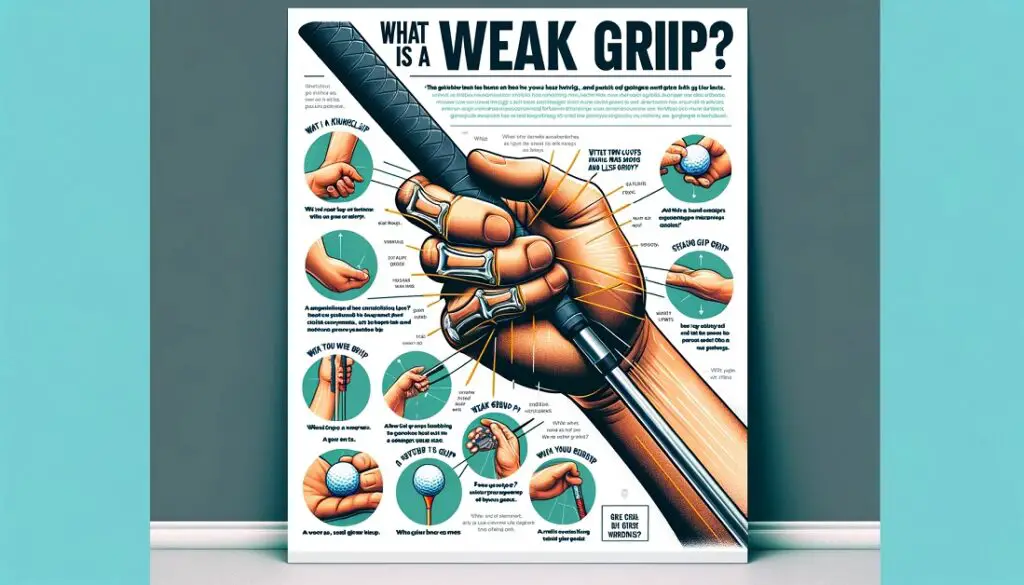
A weak grip not only refers to a reduced capacity to exert force with one’s hand and fingers, but it also indicates possible underlying health or functioning concerns. It is defined by the inability to securely hold, grab, or exert pressure with the hands, which can have a substantial impact on daily activities such as opening jars and gripping a driving wheel firmly.
Understanding a weak grip from a holistic standpoint means acknowledging its numerous consequences, which range from little inconveniences to serious health problems. This acknowledgment opens the door to treating the root reasons and investigating techniques to strengthen grip strength, ultimately improving both functionality and health consequences.
Benefits Of A Weak Grip In Golf
In the dispute over strong vs weak golf grips, particularly in sports and physical activities, each side has distinct advantages and optimal uses. A weak grip, despite its name, does not indicate a lack of strength or capability. Instead, it refers to hand positioning, with the grip focusing on strategic placement and elegance rather than violent contraction.
Improved Precision And Control
One of the primary benefits of a weak grip, particularly in sports like golf, is the increased precision and control it provides. Athletes discover that a looser grip on the club gives them more control over the direction and trajectory of the ball. This control is critical when accuracy is more important than power, such as when entering data or navigating hazards on a course.
Reduced Risk Of Overuse Injuries
A softer grip puts less strain on the muscles and joints of the hand, wrist, and forearm. This can considerably reduce the risk of overuse injuries, which are common in sports and activities involving repetitive motions. According to health data, overuse injuries account for around half of all sports-related diseases. Adopting a weaker grip can be a deliberate decision to ensure longevity in one’s sport or activity of choice.
Improved Flexibility And Range Of Motion
Using a weak grip often results in a wider range of motion. In tasks that require fine motor abilities, such as painting or playing certain musical instruments, a looser grip allows for more nuanced and diverse movements. This flexibility can contribute to better performance and the capacity to execute intricate techniques that a stronger grip may impede.
Better Energy Conservation
A weak grip might also help to conserve energy. Individuals can lengthen the duration of their activity by using less force, whether it’s climbing, playing a musical instrument, or participating in sports. This efficiency is especially useful in endurance sports or long practice sessions, where energy conservation is critical.
Disadvantages Of A Weak Grip
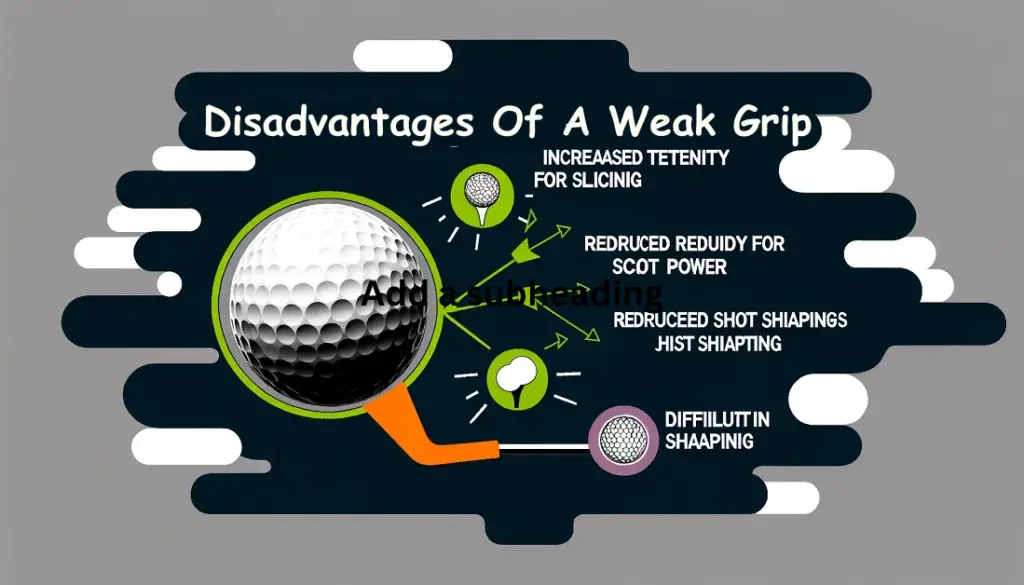
While a weak grip has many advantages in certain situations and sports, it is also important to understand its limitations and potential disadvantages. Understanding these can help people make better-educated decisions about when and how to alter their grip strength based on their activities and goals.
Decreased Power And Force
One major disadvantage of a weak grip is a decrease in power and force output. This limitation is most obvious in activities that rely on strength and explosive force, such as weightlifting, climbing, or throwing. For example, a study published in the Journal of Strength and Conditioning Research discovered that grip strength substantially correlates with overall muscle endurance and performance in athletes. Thus, a weaker grip may hinder performance in strength-dependent fields.
Potential For Inefficient Technique
A weaker grip can often result in inefficient approaches, particularly in sports or activities where the grip is critical to performance. Athletes may overcompensate for a lack of grip strength by using unfavorable body mechanics, resulting in poor form and greater injury risk. This is evident in weightlifting, where a strong grip is required for appropriate form and technique in exercises such as the deadlift and snatch.
Limitations In Skill Progression
A weak grip can be a restricting factor for sportsmen and anyone who wants to improve their ability and performance level. As the demands of their sport or activity increase, so does the necessity for a grip that can resist higher forces and provide more control. Without addressing grip strength, individuals may struggle to grow or improve in their chosen activity, whether it’s lifting bigger weights in the gym or doing more intricate movements in sports.
When To Use The Weak Grip
When selecting when to use a weak grip, it is critical to examine the activity’s individual needs and peculiarities. A weak grip is especially useful in situations that need accuracy, control, and elegance rather than overwhelming strength. Golf is an example of how a weaker grip can improve shot accuracy and trajectory, particularly in putting or short games when delicate touches are required. Similarly, in artistic and fine motor activities like painting or playing certain musical instruments, a less strong grip allows for more expressive and nuanced movement.
In medical operations, particularly surgeries, a looser grip on tools can improve precision and reduce fatigue, resulting in better outcomes. As a result, the weak grip is best suited to situations in which movement quality and precision outweigh the requirement for strength, providing a strategic advantage in gaining superior control and finesse.
How To Use The Weak Grip

When discussing the utility of a weak grip and various grip disciplines, it is critical to recognize its strategic advantages rather than dismiss it as a disadvantage. A weak grip, defined by less forceful hand and finger positioning on tools, equipment, or even in handshake scenarios, can provide distinct benefits across a variety of activities, particularly in sports such as golf or activities that require delicate handling.
For example, in golf, a weak grip can benefit players who struggle with slicing the ball, a typical problem in which the ball curves sharply to the right for right-handed players and the left for left-handed players. Adjusting their grip to a weaker position, with their hands rotated more towards the target, makes the clubface less likely to open upon contact, lessening the severity of the slicing. It’s a subtle tweak that demonstrates the significance of grip technique in improving performance outcomes.
Statistics from sports biomechanics studies reveal that even little grip alterations can cause major variations in the trajectory and spin of a golf ball, with a considerable percentage of professional players modifying their grips based on the shots they want to play. This realization reinforces the broader principle that, far from being intrinsically inferior, a weak grip can be a strategic option for gaining more precise control and desirable performance outcomes in a variety of situations.
Explore More: Driver Grip vs Iron Grip: Which Is Right For You?
Finding The Ideal Golf Grip for Your Game
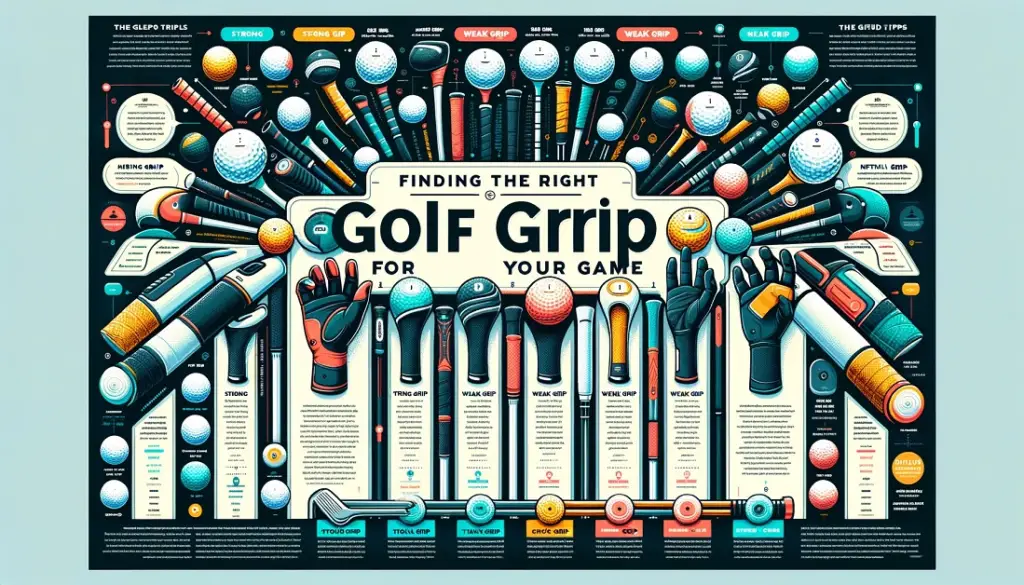
The search for the ideal golf grip for a golfer is a very personal journey impacted by your playing style, strengths, and the unique challenges you experience on the course. Understanding whether a strong or weak grip is more suited to your game requires a combination of self-assessment, experimenting, and, in certain cases, coaching. Here’s an organized technique to help you decide which grip is best for you.
Assess Your Current Performance: Begin by examining your current game. Do you routinely slice or hook your shots? Your grip could be contributing to these troubles. A hard grip is commonly recommended for players who hook the ball because it helps square the clubface upon contact. If you’re having trouble with slicing, a weak grip may assist widen the clubface somewhat to counteract this inclination.
Consider Your Strength and Flexibility: A strong grip can improve control and power for players with high strength and wrist flexibility, enabling more aggressive strokes and better handling of heavier clubs. If your physical qualities favor finesse over power, a weak grip may provide more precision and control, especially with lighter clubs.
Experiment on the Range: Experimentation is essential. Spend time on the driving range trying out both strong vs weak grip in golf to discover which one enhances your shot quality. Pay close attention to the ball’s flight, control, and any changes in your comfort level. It’s critical to give each grip type enough trial time; quick adjustments can feel awkward at first but may be useful in the long run.
Analyze Your Shot Patterns: Keep track of your shot patterns across all grip styles. Are your shots regularly too far left or right? Is it easier for you to control the direction and trajectory of the ball with one grip over another? This analysis can provide actual evidence to assist you make an informed decision.
Seek Professional Advice: A professional golf coach can offer vital insight into your grip selection in golf weak vs strong grip. They may examine your swing, make suggestions, and help you comprehend the differences between grip styles about your entire technique.
Consider Comfort and Consistency: Ultimately, the optimal grip for you is both comfortable and offers consistent outcomes. Comfort leads to confidence, and consistency is essential for improving your game over time. If a particular grip type consistently produces superior outcomes and feels natural, it’s probably the best fit for your game.
Statistics to Consider: While personal preference and play style are important considerations when selecting a strong or weak grip golf, studies have shown that players who switch to a grip type that corrects their unique swing faults can increase shot accuracy and consistency by up to 20%. Furthermore, a poll of amateur golfers indicated that 75% reported significant gains in their game after receiving professional grip instruction.
Related Article: If your in the struggle of finding the right grip. Then you also need to know about the “Interlocking vs Overlapping golf grip” in our detailed guide.
Final Thoughts
To summarize, choosing between a strong golf grip vs weak golf grip does not involve finding a one-size-fits-all answer, because there isn’t one. When working on your golf swing, remember to use a golf weak grip vs strong grip and pay attention to the position of your index finger for better control and accuracy It’s all about what works best for you, your style, and how you approach the game. If you’re slicing the ball all over the place, experimenting with a weak grip golf may help you straighten out your shots. If you’re hooking it, a stronger grip may assist.
Don’t be scared to experiment on the driving range; try a golf weak grip vs strong grip and see how it feels and what shots you hit. If you’re stuck, speaking with a golf coach can provide you with expert advice customized specifically to your needs.
Remember, the idea is to select a strong and weak golf grips that feels comfortable in your hands and allows you to smash shots more consistently. It may feel strange at first to shift your grip but give it time. You might be surprised to learn that just a minor tweak might have a significant impact on your game. Finally, golf is about having fun and improving one shot at a time.
Read More: Golf Grip – Strong, Weak or Neutral

With several years of experience in golf, Golf Golz are dedicated to helping golfers elevate their game through innovative training techniques, premium equipment, and expert insights. From mastering your swing to conquering the course, we bring you strategies and tools designed by world-class instructors to help you play your best golf yet.

